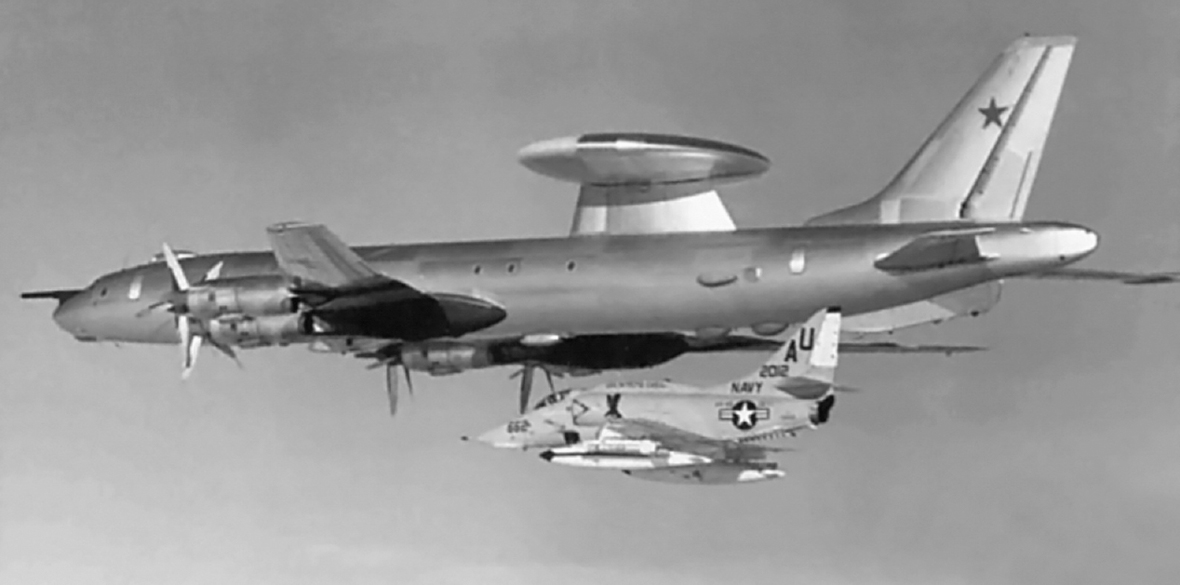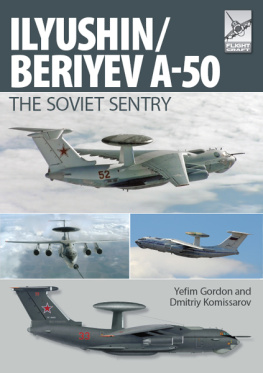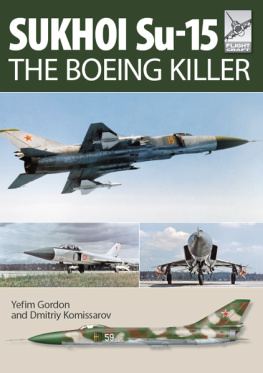Title Page: A fine study of A-50 Mainstay-A 41 Red making a low flypast.
First published in Great Britain in 2014 by Pen and Sword Aviation
An imprint of Pen & Sword Books Ltd
47 Church Street, Barnsley, South Yorkshire, S70 2AS
Copyright Yefim Gordon and Dmitriy Kommissarov, 2014
ISBN: 978 1 47382 391 4
EPUB ISBN: 978 1 47385 358 4
PRC ISBN: 978 1 47385 367 6
The right of Yefim Gordon and Dmitriy Komissarov to be identified as Authors of this work has
been asserted by them in accordance with the Copyright, Designs and Patents Act 1988.
A CIP catalogue record for this book is available from the British Library
All rights reserved. No part of this book may be reproduced or transmitted in any form
or by any means, electronic or mechanical including photocopying, recording or by any
information storage and retrieval system, without permission from the Publisher in writing.
Printed by Printworks International
Pen & Sword Books Ltd incorporates the Imprints of Pen & Sword Aviation, Pen & Sword
Family History, Pen & Sword Maritime, Pen & Sword Military, Pen & Sword Discovery,
Wharncliffe Local History, Wharncliffe True Crime, Wharncliffe Transport, Pen & Sword
Select, Pen & Sword Military Classics, Leo Cooper, The Praetorian Press, Remember When,
Seaforth Publishing and Frontline Publishing
For a complete list of Pen & Sword titles please contact
PEN & SWORD BOOKS LIMITED 47 Church Street, Barnsley, South Yorkshire, S70 2AS, England
E-mail:
CONTENTS

Introduction
S urprise was always one of the key elements of success during offensive air operations, be it counterair, bombing/attack or reconnaissance missions. Accordingly, it was vital for those on the receiving end to learn of the enemys approach in advance. Originally the side being attacked had to rely on human observers and telephone or radio communication. The development of radar technology made possible the advent of radar picket ships; the next obvious step was to develop a technology initially known as airborne early warning (AEW). A key function of such flying radar pickets control of friendly fighters or strike aircraft soon led the designation to be amended to airborne early warning and control (AEW&C) or airborne warning and control system (AWACS).
Development of AEW aircraft began in earnest after the Second World War. Initially the USA and Great Britain were the main developers and users of this technology. Shipboard AEW aircraft intended for protecting naval task forces (especially aircraft carriers, which are vulnerable and lucrative targets) were of necessity compact because of space constraints during on-deck storage or below-deck stowage. The shore-based ones, on the other hand, were unencumbered by such limitations and could be based on transport aircraft or airliners, offering greater fuel capacity (which meant longer endurance) and room for a relief crew.

A Tu-126 AWACS of the 67th Independent AEW Squadron in flight.
Thus, in 1949 Lockheed Aircraft brought out a radar picket version of the L-749 Constellation piston-engined airliner designated PO-1W (later WV-1); a more advanced version based on the L-1049 Constellation followed in 1953 as the WV-2 Warning Star, becoming the EC-121K in 1962. A successor to the Warning Star was developed, using the Boeing 707-320B four-turbofan airliner as the basis. Originally known as the EC-137D and subsequently redesignated E-3A Sentry, this aircraft first flew in 1972 and entered service in 1977. Unlike the predecessor, which had conventional fixed radomes, it had the surveillance radar antennas mounted in a distinctive lentil-shaped revolving housing a so-called rotodome carried above the fuselage on twin pylons. A succession of versions with ever more capable avionics (and, later, new CFM56-2A2 engines) was brought out; the E-3 is arguably the best-known AWACS aircraft which, apart from the US Air Force, has seen service with the NATOs AEW Force in Europe, the air arms of the UK, France and Saudi Arabia. As a successor to the Sentry, in 1991 Boeing developed the E-767 based on the Boeing 767-200ER twin-turbofan airliner; the type entered limited production in 1992.
Meanwhile, in the Soviet Union the airborne early warning issue was taken equally seriously; the Soviet political and military leaders were reasonably well informed on military technology development in the West and on the strengths and flaws of their own national air defence system, too. As the West developed new offensive weapon systems capable of striking across the North Pole, the northern and Far Eastern regions of the Soviet Union were no longer safe. Building and operating airbases and air defence (AD) radar systems in those parts was difficult, if not impossible, due to the harsh climatic conditions and logistics problems. To close that hole in the Soviet air defence network, the Air Defence Force (PVO Protivovozdooshnaya oborona) needed AEW&C assets comparable to those developed in the West.

A Tu-126 is shadowed over the Mediterranean Sea by Douglas A-4E Skyhawk BuNo 152012 (AU-652) of attack squadron VA-45/Det.1 Blackbirds from the aircraft carrier USS Intrepid in 1973.
On 4th July 1958 the Soviet Council of Ministers (= government) issued a directive tasking OKB-156 (opytno-konstrooktorskoye byuro experimental design bureau) headed by General Designer Andrey N. Tupolev with creating an AWACS aircraft. The aircraft was to be designed around the newly-developed Liana (Creeper) radar/communications suite created by the Moscow Research Institute of Instrument Engineering (NII-17, or MNIIP Moskovskiy naoochno-issledovatelskiy institoot priborostroyeniya) under General Designer Vladimir P. Ivanov. The Liana radar had phenomenal performance by the days standards; detection range in the upper hemisphere was to be 100 km (62 miles) for a fighter-size target, 200 km (124 miles) for a tactical bomber and 300 km (186 miles) for a strategic bomber. Detection range below the horizon, however, was limited to only 20 km (12.4 miles).
The Tupolev Tu-114 Rossiya (Russia) four-turboprop long-haul airliner (NATO reporting name Cleat) was selected as the mission platform for the Soviet AWACS. Designated Tu-126 or izdeliye L (product L a reference to the Liana suite), the aircraft had the radar array in a rotodome mounted on a thick single pylon about halfway between the wings and the vertical tail; it was the worlds first aircraft to feature a rotodome. Radiation shielding was applied to protect the crew from the powerful high-frequency radiation generated by the mission equipment. The Tu-126 had a flight crew of six and a mission crew of six; a relief crew was also carried. Additionally, the aircraft was equipped with a probe-and-drogue in-flight refuelling (IFR) system allowing it to remain airborne for up to 11 hours.
The prototype was completed in late 1961, making its first flight on 23rd February 1962. Due to the very special mission fulfilled by the aircraft only eight production Tu-126s were built in 1965-67. On 30th April 1965 the type was formally included the into the PVO inventory, serving with the 67th Independent AEW Squadron based at Siauliai (pronounced
Next page











